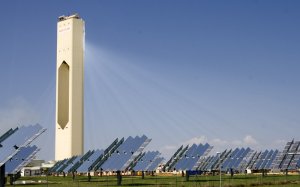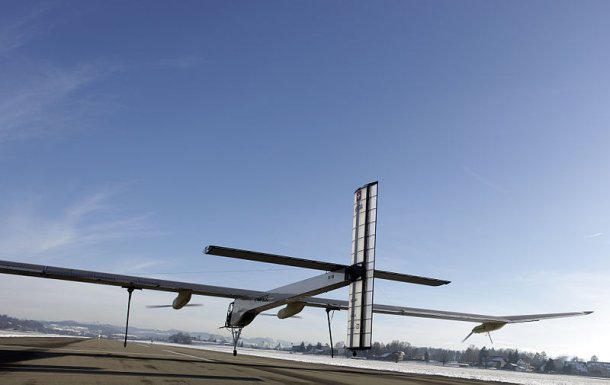3,850 zettajoules, a figure with 22 zeroes in it–that’s how much solar radiation our planet receives from our sun in a year.
To get a sense of how much potential energy that number represents, consider that in just one hour, the shining of the sun unleashes enough power to supply the sum of humanity’s global energy needs for an entire year. And with our current level of solar technology, we would only need about 0.3% of the earth’s land surface to harness that energy.

This map shows the natural distribution of solar energy across the world. Just the solar areas covered by black discs would be sufficient to meet the world's primary energy demand. (Photo credit: Wikipedia)
Solar power clearly holds big promise, and it is currently the most competitive renewable energy on the market. Given the numerous advantages of solar energy, the industry is preparing to make scalable contributions to stressed electrical grids in the United States and beyond. But there are disadvantages of solar energy, too, and significant limitations remain.

The Solucar PS10 is the world's first tower-based commercial solar thermal power plant.
Cost is still perhaps the biggest disadvantage of solar energy. So far, solar successes have been heavily dependent on government subsidies to help reduce bottom line costs, but rapid innovation is bringing change. Emerging technologies, from nanowires to fuel cells, are positioning solar as the next big player on the grid. There will likely be big changes in the following years as new materials and designs come online, enhancing our ability to distribute sun-derived power in an intelligent and efficient fashion.
Let’s take a look at the current state, growth over time, and future potential for solar power as a major supplier of our collective energy needs. We’ll focus on solar energy advantages and disadvantages in terms of the environment, reliability, efficiency and economic cost.
Environment
When it comes to the environment, solar power makes a lot of sense. It results in minimal pollution - about 90% less than conventional fossil fuels. Sunshine is endlessly renewable, and more often than not solar installation components are recyclable. It is also widely available around the world.
Our current energy consumption, which depends mainly on raw fossil fuels like coal and oil, is associated with chronic water and air pollution, impending “peak” supplies, and aggravating global warming.
The advantages of solar energy are clearest concerning the environment and public health. 100% renewable solar power presents a tremendous opportunity to turn away from an economy based on some of the world’s dirtiest resources. It is arguably the renewable resource best positioned to take on this role in the broader mix.
Reliability

Nellis Solar Power Plant in Nevada, USA. This 140 acre installation provides 14MW of power to the nearby air force base. (Photo credit: Wikipedia)
Is solar power reliable? One of the key disadvantages of solar energy is its “intermittent” nature. That means solar radiation is nil at nighttime, and weak on overcast days. This trait makes solar currently inadequate for meeting base load demand—the real meat-and-potatoes wattage needed to power society.
In the United States, the Department of Energy (DOE) is proactively pushing exactly that flavor of innovation through Stanford’s SLAC National Accelerator Laboratory in Menlo Park, California. Here, the DOE is funding promising research into a new kind of battery.
Reportedly, it’s cheap and durable enough to store solar and wind on the grid for large scale use. The battery, which uses chemical storage comparable to a reversible fuel cell, could equip electrical grids with renewable storage capacity on a revolutionary new scale.
Stanford’s new battery, hooked up to a grid, could theoretically conserve excess power from off-peak periods and conveniently discharge it during demand spikes. An adequate battery would enable a smooth, direct connection between demand and load. It would be a huge boon for the solar industry. This kind of storage capacity is a necessary component for any major grid-supplying energy source.
Efficiency
Efficiency ratings are another sticking point associated with today’s solar technologies. They are somewhat limited in terms of how well they are able to maximize electricity conversion while minimizing light lost as waste heat. According to Science Daily, most commercial panels today are no more than 25% efficient, with an average hovering between 11% and 15%.
These limits are not set in stone; what was once considered an absolute cap on efficiency is now negotiable, and the latest gadgets show solar conversion rates of up to 44%. While researchers will no doubt find more ways to optimize solar efficiency, the real test hinges on the cost of developing the means. That is, any solution must resolve efficiency gaps in a cost-effective and scalable fashion.
Efficiency is a key dimension of renewable energy; inefficiencies translate into waste and ecological harm. Solar systems yield 100 times more power over their operational life than either nuclear or fossil fuels. So, the good news is increased solar usage will improve the overall efficiency of the energy economy, even with existing technology. In the long run, solar represents a move towards less overall waste.
Economic Costs
Is solar power affordable or expensive? The answer is not straightforward; it depends on numerous factors. There are, however, some key trends to note.
Solar startup costs are high, usually requiring a sizable initial investment which recoups itself over a predictable time frame. All else being equal, larger installations benefit from a lower cost-per-watt. In the long run, we are looking at a potentially inexpensive, scalable way of powering up which pays for itself many times over.
But we are not there yet. Much of the solar market’s presence is backed by government subsidies that help keep costs down, including a 30% federal tax credit in the U.S. This support has given the sun’s rays a foot in the door, but markets are unpredictable and a lot could happen in a very short time.
Nevertheless, the consistent trend since the 1980s is ever-cheaper sun power. The cost-per-watt has fallen steeply over the last ten years in particular, and this pattern is likely to continue for the foreseeable future.
What’s next for solar energy?
Solar energy pros and cons are likely to shift under different conditions. Look for cost-effective financing to link up with scalable new storage and efficiency technologies. Resolution of solar power’s disadvantages in the areas of efficiency, startup costs, and reliability would be a strong signal of the sun’s readiness to take on the bigger, dirtier power players.
If you enjoyed this look at solar energy pros and cons, you should check out this list of interesting facts about solar energy.
author: Editorial Staff categories:
- Environment date: 2013-05-30T14:51:02Z guid: https://curiosityaroused.com/?p=725 id: 725 thumbnail: wp-content/uploads/solar-impulse-420x385.jpg title: 10 Interesting Solar Energy Facts url: /environment/interesting-solar-energy-facts/
Solar panels are quickly becoming one of the most popular clean-energy options on the market. A study conducted by Forbes proved solar power is the 10th fastest-growing industry in the United States.

Nellis Solar Power Plant in Nevada, USA. This 140 acre installation provides 14MW of power to the nearby air force base. (Photo credit: Wikipedia)
Despite the hype surrounding this technology, there remains a wealth of solar energy information that is unknown to many. Understanding the solar power facts listed here could be the difference between budget-busting power bills and clean-energy savings.
1. Solar panels are more affordable than ever.
There are several factors contributing to the recent drop in solar panel cost. New tax benefits introduced by the Obama Administration allow an individual to write off 30 percent of the panel installation cost. There is no limit to the amount that this 30 percent can reach, which promotes investment in quality panels.
Power Purchase Agreements (PPAs) are making clean energy affordable to those who, until a few years ago, would have never considered investing in solar power. Companies that offer PPAs install solar panels and maintain them for free. The property owner pays the same energy bill as before plus a small premium until the cost of the solar panels is paid off. In the end, everybody wins. The company makes a small profit in the long term, and the property owner has solar power. Companies that manufacture solar panels also benefit from PPAs due to an increase in sales volume.
2. Solar power is the 10th fastest-growing industry in the United States.
Due to improved manufacturing processes and the recent affordability of solar power, the industry is booming. Shell Oil predicts that 50 percent of the world’s energy will come from renewable sources by 2040. With public concern about global warming escalating, the industry is playing a bigger role in world economics.
3. About 30 percent of energy consumption is used to heat water. This task can be accomplished by solar water heating (SWH) systems.
The two common types of solar water-heating systems are the “close-coupled” system and the “pump-circulated” system. In a “close-coupled” system, a storage tank is mounted above solar collectors. No pumping is required because the hot water rises into the tank due to thermosiphon flow. In a “pump-circulated” system, a storage tank is floor- or ground-mounted and is situated below the collectors. A pump moves the water between the collectors and the tank.
4. Each month, a 1-kilowatt solar panel array will prevent approximately 170 pounds of coal from being burned and save more than 100 gallons of water.
This statistic is especially remarkable since most solar power systems produce more than 1-kilowatt per day.
5. A solar-powered aircraft flew more than 4,000 km across the USA.

HB-SIA Solar Impulse - world distance record holder for solar aviation (Set May 2013)
6. Solar panels can earn money for the property owner.
If solar panels produce a surplus of energy, that energy is fed back into the power grid. In most states, the utility company will provide financial compensation to the property owner for this contribution. Solar panels not only save the environment and reduce power bills, but also can produce an unexpected pay check every month.
7. Even fossil fuels are products of solar energy.

Coal, a fossil fuel formed by anaerobic decomposition of buried dead organisms
8. The world’s largest solar electric system was built in Germany.
Bavaria Solarpark is a 10-megawatt solar electric system that covers 62 acres. This system comprises an astonishing 57,600 photovoltaic panels.
9. Each year, Australia hosts a 3,021 km car race for solar-powered vehicles. In the first race, which took place in 1987, the drivers’ average speed was 67 km/hr. By 2005, it jumped to 103 km/hr!
Car exhaust is a leading cause of global warming. This race spreads awareness of solar-powered vehicles and demonstrates a dramatic leap in solar-power innovation.
10. 99.99 percent of all solar energy remains untapped.

This map shows the natural distribution of solar energy across the world. Just the solar areas covered by black discs would be sufficient to meet the world's primary energy demand. (Photo credit: Wikipedia)
In Australia, the available solar energy is approximately 15,000 times greater than the country’s energy consumption. If all of this power was captured, it would amount to 2,000 times more than the nation’s usage.
Solar energy can be a lucrative asset for the individual, but only if he or she understands how to benefit from new innovations and monetary policies. Although these facts about solar energy address a number of solar-power concerns, new solar energy facts are being published almost daily. Staying up-to-date with clean-energy options could mean big savings for businesses and families.
If you enjoyed this list of facts about solar energy, you can read more about the pros and cons of solar energy here.